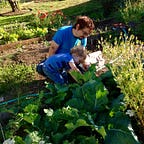Debugging “Wild”
What does “ReWilding” mean, anyhow?
What if there’s no such thing as “Wild”?
Wait, let me back up.
What if the big problem in the algorithm called “A Healthy Environment” is an error in the code?
What if someone, at some point, accidentally inserted a line of code that gave this:
…a different value than this:
Or that this:
…is fundamentally different than this:
Is human agriculture (when done right) actually different — not as a process, but as a value — than what trees do when they grow leaves, or what ants do when they harvest honeydew from aphids?
Are humans who plant corn seeds really carrying out the “long-term plan” of the wild teosinte ancestor of corn?
Are we really so clear on how Social Networking “works” in the Cyber-Ecosystem?
Take “ReWilding” as a case study. What the heck is it?
Those of us into “eco” are likely familiar with the term. There are two different manifestations of ReWilding. The first is the concept as used in conservation biology (emphasis mine):
…[L]arge-scale conservation aimed at restoring and protecting natural processes and core wilderness areas, providing connectivity between such areas, and protecting or reintroducing apex predators and keystone species.
What, however, is a “core wilderness area,” and, more interestingly, what is NOT a “core wilderness area”?
What if we decided that EVERYTHING is a “core wilderness area,” even our cities, towns, and communities?
Another question concerns the concept of “keystone species” and native plants. As the climate changes, how will we be able to decide the difference between “natives” and “invasives?”
If we’re going to “rewild,” do we eliminate so-called “invasives,” or would it be better to find new ways to work with them?
In a warmer world, how many resources do we want to spend trying to “return” an area to “Wild” State 1.0 when the climate has already been updated to Version 2.6?
Some proponents of restoration ecology have addressed this by essentially claiming that this isn’t the actual intention, that restoring individual entities isn’t part of the plan, but a growing number of individuals are increasingly interested in bringing extinct species back to life:
I mean, does anybody else have “PRECAUTIONARY PRINCIPLE” flashing in their head in big red letters at the moment?
The other, more prevalent version of “ReWilding” concerns how people can “rewild” themselves:
ReWilding.com defines it as:
…[R]estoring ancestral ways of living that create greater health and well-being for humans and the ecosystems that we belong to…. Rewilding learns from the examples of indigenous people past and present provided by anthropology, archaeology, and ethnobiology.
The problems with this characterization are pronounced.
The characterization of “ancestral” and “indigenous ways of living” as “wild” is SUPER problematic.
Calling indigenous cultures “Wild” reduces them to a stereotype and eliminates the complexity of native cultures from every geography.
Proponents of this kind of ReWilding take you all over the place, from faddish conceits like the Paleo Diet and Barefoot Walking to questionably useful (but inarguably more fun) skills like Archery. This movement is also dominated by the affluent and privileged who can afford to take the time to get out of town and buy organic and walk around barefoot.
However, they all have one thing in common: they all advise us that everybody needs to “get out into nature more,” to “get out of the cities,” to go out into, and somehow become, “the Wild.”
This reveals the biggest problem with this kind of ReWilding:
The biggest problem with this kind of ReWilding is that it is an excuse to ignore whatever we don’t want to consider “Wild.”
Listen: if you are in an office building at a desk, reading this on a computer, you are just as much “in the wild” as you would be if you were in the woods in Alaska. You’re still in an ecosystem.
You’re still participating in an ecology.
And, the very idea that someone walking down the street in a city is less in “the wild” than someone on a trail is what got us into this mess in the first place.
Think about it: if we programmed our activities as parts of a living system with the same value as the whole, we’d inherently recognize the value in keeping the water clean, keeping trees alive, keeping toxins out of the soil and the air.
If we didn’t see “Wild” and “Urban” as different, but understood our technology the way plants understand the technology of the forest or microorganisms understand the technology of the microbiome, we’d have a lot less to explain to our grandkids right now.
One stupid line of code in our societal algorithm, and now we’re looking at wildfires and missing sea ice.
The fact is, “Wild” is a terrible signifier, and “ReWilding” is a broken idea. “Wild and Urban/Civilized are Different” is a bad line of code, and “ReWilding” as a concept and as a movement underlines this point.
